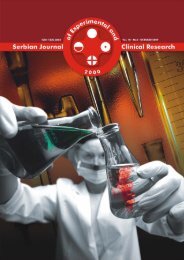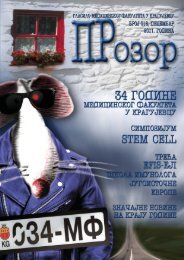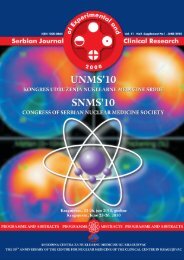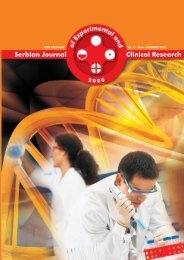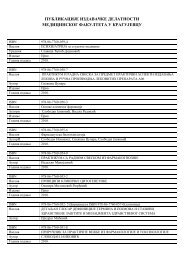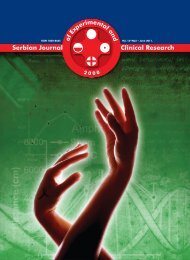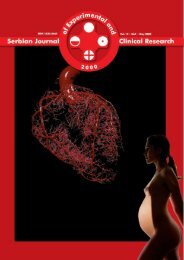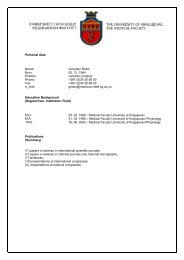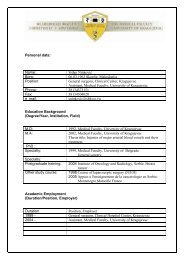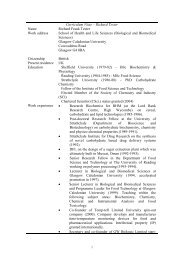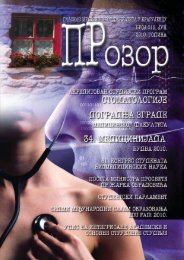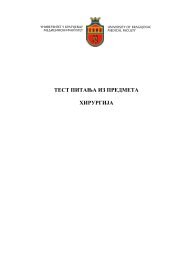neurotoxicity and mechanisms of induced hyperexcitability
neurotoxicity and mechanisms of induced hyperexcitability
neurotoxicity and mechanisms of induced hyperexcitability
Create successful ePaper yourself
Turn your PDF publications into a flip-book with our unique Google optimized e-Paper software.
tral regions <strong>of</strong> the mPFC (the prelimbic <strong>and</strong> the infralimbiccortices) have been associated with diverse emotional<strong>and</strong> cognitive processes [43, 46, 47]. The ventral mPFCis also <strong>of</strong> interest, as it has been strongly implicated inthe expression <strong>of</strong> behavioural <strong>and</strong> autonomic responsesto emotionally relevant stimuli [48]. As dysfunction <strong>of</strong>the prefrontal cortex has been repeatedly implicated inthe pathophysiology <strong>of</strong> schizophrenia [49-52], studies inthe rat have focused on elucidating the role <strong>of</strong> this regionin paradigms such as locomotor activity <strong>and</strong> prepulse inhibition.Dopaminergic lesions <strong>and</strong> intra-mPFC infusion<strong>of</strong> selective dopamine receptor antagonists have beenreported to disrupt prepulse inhibition [53, 54], whereasthe intra-mPFC infusion <strong>of</strong> amphetamine has been shownto decrease systemic amphetamine-<strong>induced</strong> increases inlocomotor activity in the open field test [55]. However,none <strong>of</strong> these studies have addressed the importance <strong>of</strong>serotonergic innervation <strong>of</strong> the mPFC in neural circuitryinvolved in the regulation <strong>of</strong> motor behaviour <strong>and</strong> prepulseinhibition. Therefore, the present study investigatedthe effects <strong>of</strong> local lesions <strong>of</strong> serotonergic projections intothe mPFC on psychotomimetic drug-<strong>induced</strong> locomotorhyperactivity <strong>and</strong> prepulse inhibition.MATERIALS AND METHODSExperimental animalsA total <strong>of</strong> 25 male Sprague-Dawley rats (Department<strong>of</strong> Pathology, University <strong>of</strong> Melbourne), weighing 250-300 g at the time <strong>of</strong> surgery, were used in this study. Theanimals were housed under st<strong>and</strong>ard conditions in groups<strong>of</strong> two or three with free access to food <strong>and</strong> water. Theywere maintained on a 12 h light/dark cycle (lights on at0700 h) at a constant temperature <strong>of</strong> 21ºC. One week priorto the surgical procedure, the animals were h<strong>and</strong>ledeach day over a five-day period. The experimental protocol<strong>and</strong> surgical procedures were approved by the AnimalExperimentation Ethics Committee <strong>of</strong> the University <strong>of</strong>Melbourne, Australia.Drugs <strong>and</strong> solutionsD-amphetamine sulphate (Sigma Chemical Co., St.Louis, MO, USA) <strong>and</strong> phencyclidine HCl (PCP, Sigma)were dissolved in a 0.9% saline solution <strong>and</strong> injected subcutaneously(s.c.) into the nape <strong>of</strong> the neck. DesipramineHCl (Sigma) was dissolved in distilled water <strong>and</strong> injectedintraperitoneally (i.p) 30 min prior to the neurotoxin microinjection.All doses are expressed as the weight <strong>of</strong> thesalt <strong>and</strong> were administered in an injection volume <strong>of</strong> 1 ml/kg body weight. The serotonergic neurotoxin, 5,7-dihydroxytryptamine(5,7-DHT) (Sigma), was dissolved in 0.1%ascorbic acid (BDH Chemicals, Kilsyth, VIC, Australia) insaline to prevent oxidation <strong>of</strong> the neurotoxin. Carpr<strong>of</strong>en(50 mg/ml, Heriot AgVet, Rowille, VIC, Australia) was dilutedin 0.9% saline to a dose <strong>of</strong> 5 mg/kg <strong>and</strong> injected s.c.immediately after the surgical procedure.Surgical procedureThe rats were pretreated with 20 mg/kg desipramine,30 min prior to surgery, to prevent the destruction <strong>of</strong> noradrenergicneurons by 5,7-DHT [56]. The rats were subsequentlyanaesthetised with sodium pentobarbitone (60mg/kg i.p., Rhone Merieux, QLD, Australia). The rats weremounted in a Kopf stereotaxic frame (David Kopf Instruments,Tujunga, CA, USA) with the incisor bar set at –3.3mm [57]. The skull surface was exposed, <strong>and</strong> a small holewas drilled. A 25 gauge stainless-steel cannula, which wasattached to a 10 μl glass syringe <strong>and</strong> connected via polyethylenetubing mounted in an infusion pump (UltraMicro-Pump, World Precision Instruments, Sarasota, FL, USA),was lowered into the mPFC. With bregma set to zero <strong>and</strong>the stereotaxic arm at 0º, the coordinates were as follows:mPFC lesions (n=13 for behavioural experiments, n=2 forhistology): 3.2 mm anterior, 0.7 mm lateral <strong>and</strong> 4.5 mmventral to bregma. A volume <strong>of</strong> 0.5 μl <strong>of</strong> 5,7-DHT (5 μg/μl)was infused over a period <strong>of</strong> 2 min on each side. Sham-operatedcontrols (n=10) underwent the same surgical procedure<strong>and</strong> received an equal volume <strong>of</strong> vehicle solution.The injection volumes <strong>and</strong> rate <strong>of</strong> infusion were selectedto minimise non-specific damage at the site <strong>of</strong> injection.Movement <strong>of</strong> the meniscus in the cannula was monitoredto ensure successful infusion. After infusion, the cannulawas left in place for a further 2 min to avoid backflow <strong>of</strong>the solution up the injection path. After lesioning, theskin was closed with silk-2 sutures (Cynamid, BaulkhamHills, NSW, Australia), <strong>and</strong> the animals were administered5 mg/kg <strong>of</strong> carpr<strong>of</strong>en, a non-steroidal, anti-inflammatoryanalgesic, to reduce post-operative inflammation <strong>and</strong> discomfort.The rats were placed on a heated pad until theyrecovered from the anaesthesia. After the surgery, the ratswere allowed to recover for two weeks, during which theywere h<strong>and</strong>led regularly <strong>and</strong> health checks were made twoto three times a week.Experimental design <strong>and</strong> apparatusBehavioural tests were performed starting two weeksafter the surgery, <strong>and</strong> each session included r<strong>and</strong>om numbers<strong>of</strong> 5,7-DHT-lesioned rats <strong>and</strong> sham-operated rats.Locomotor activity was monitored using eight automatedphotocell cages (31 x 43 x 43 cm, h x w x 1, ENV-520, MEDAssociates, St. Albans, VT, USA). The position <strong>of</strong> the rat atany time was detected with sixteen evenly spaced infraredsources <strong>and</strong> sensors on each <strong>of</strong> the four sides <strong>of</strong> the monitor.The addition <strong>of</strong> a photobeam array above the subjectadded a second plane <strong>of</strong> detection to the system to detectrearing <strong>and</strong> vertical counts. This infrared beam array thusdefined an X, Y <strong>and</strong> Z coordinate map for the system. Thesensors detected the presence or absence <strong>of</strong> the infraredbeam at these coordinates. Every 50 msec, the s<strong>of</strong>twarechecked for the presence or absence <strong>of</strong> the infrared beamat each sensor, allowing for the very precise tracking <strong>of</strong>the movement <strong>of</strong> a subject. Several types <strong>of</strong> behaviouralresponses were recorded, including distance moved, ambulation,stereotypy <strong>and</strong> rearing. Ambulatory counts con-13



